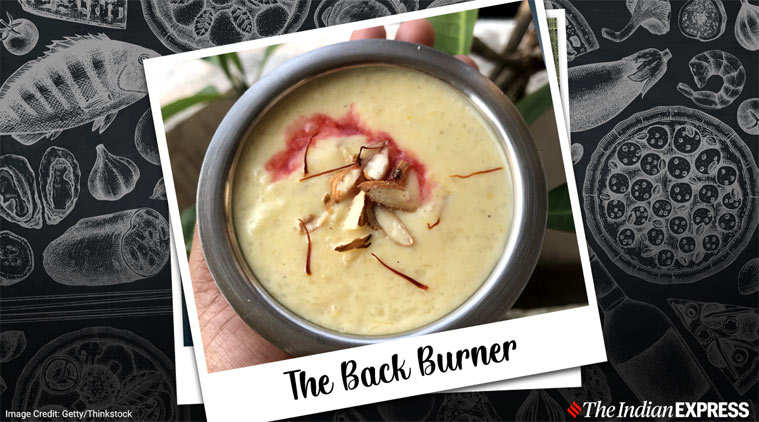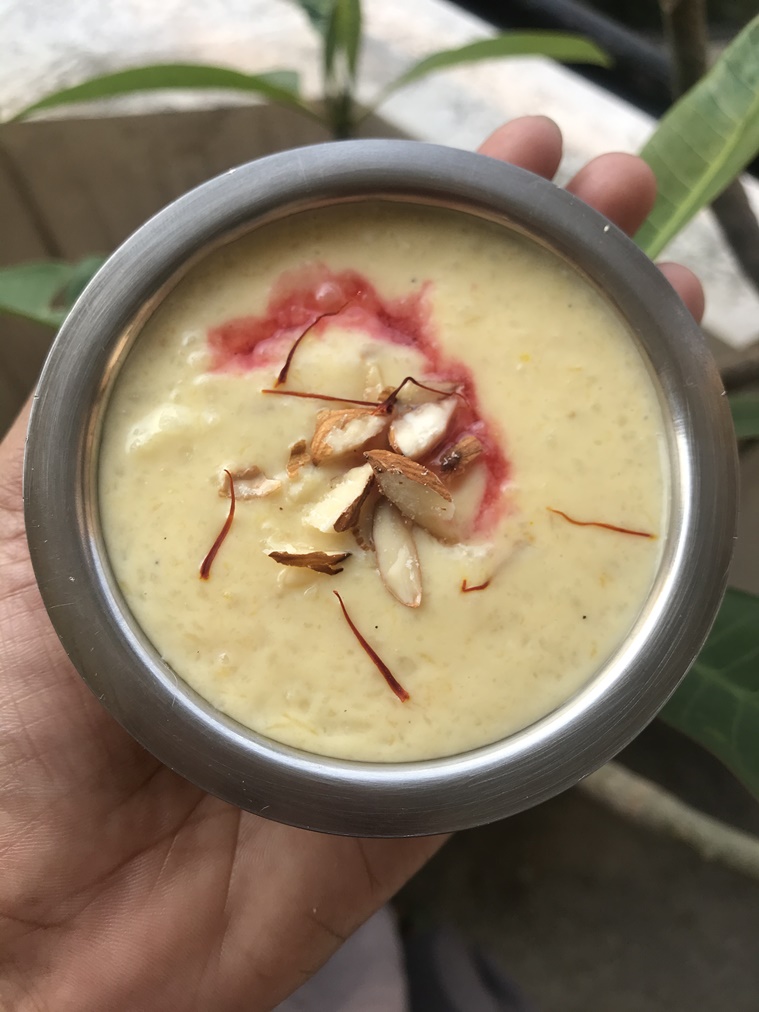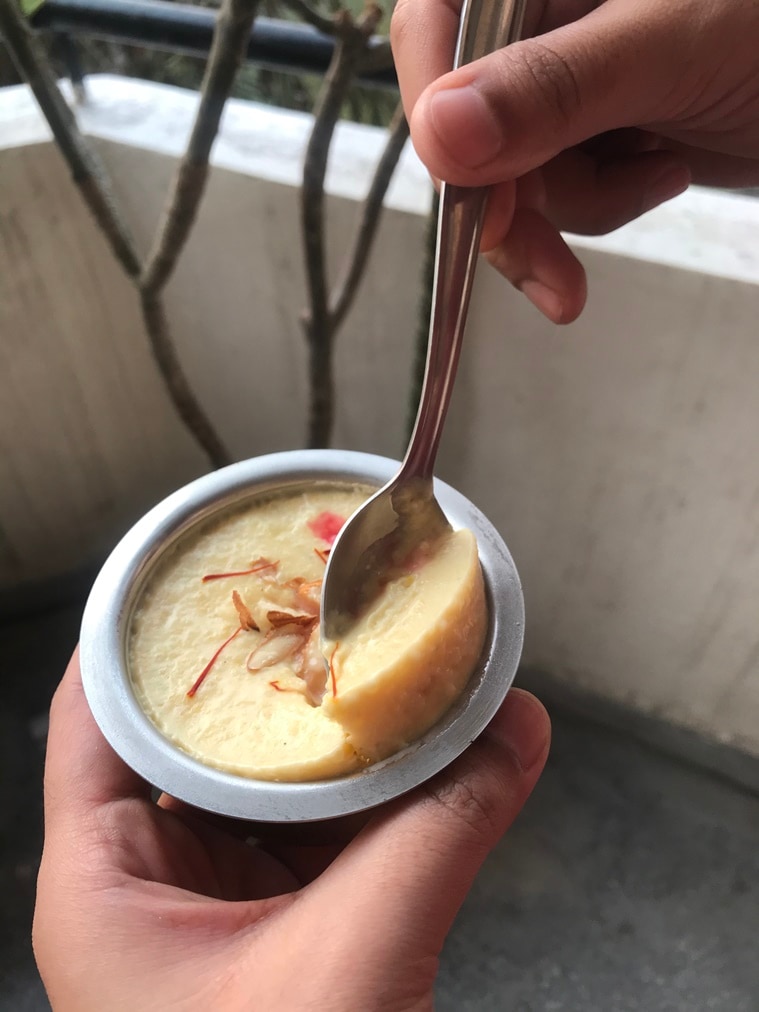 Time to make the delightful mango phirni this Ramzan. (Source: Pooja Pillai’ designed by Gargi Singh)
Time to make the delightful mango phirni this Ramzan. (Source: Pooja Pillai’ designed by Gargi Singh)
The holy month of Ramzan has begun and practicing Muslims around the world are observing this 30-day period by fasting and turning their gaze inwards and outwards onto things that, in the hustle and bustle of daily life, get overlooked. Things like the meaning of devotion and discipline, sacrifice and compassion. In most parts of the world, the fast, which begins when the sun rises, ends at sunset with a glass of water and some dates, and is followed by a feast. The feast, as I understand it, is an important counterpoint to the fast: if the latter practice helps a person fix their gaze on matters beyond the basic, material realm, the former offers an opportunity to be grateful for all that one does have in the here and now.
The above reflections have been shaped by my conversation with my friend N, who begins fasting today, far away from home, and the choice of today’s recipe was shaped by my desire to mark this period, in the only way I can, with her. I also chose to make phirni because the basic ingredients of – milk, rice, sugar – are available to almost anyone anywhere. And, it’s summer, so it had to be mango phirni.
 The basic ingredients of phirni – milk, rice, sugar – are available to almost anyone anywhere. (Source: Pooja Pillai)
The basic ingredients of phirni – milk, rice, sugar – are available to almost anyone anywhere. (Source: Pooja Pillai)
Every part of the world has its own version of the milk-rice-sugar dessert (and, in fact, it seems to be the commonest kind of dessert, apart from sweet, fried dough), from the Thai sticky rice with mango (made with coconut milk) to the German milchreis, from the Egyptian mehalabya to the Iranian fereni. All of them depend for their silky, creamy texture on the starch released by the rice — either whole or ground — as it cooks.
Which is why I’m not sure that basmati, as recommended by most modern phirni recipes (including the one I referred to in Classic Cooking of Punjab by Jiggs Kalra and Pushpesh Pant) is the best choice. I would think that rice with a higher proportion of amylopectin (the starch component that makes rice glutinous when cooked) like gobindobhog would make a better choice than basmati which has a higher proportion of amylose (which doesn’t gelatinise and therefore helps the grain retain structural integrity even when cooked). I only had basmati at hand so I used that, but I would love to use gobindobhog or even one of the fat, dark rice varieties with a nutty flavour someday to make phirni. The results are sure to be interesting.
Follow Indian Express Covid-19 tracker for latest updates
Anyway, onto the Mango Phirni recipe. Make this when you have at least a couple of hours, because while the recipe itself is simple, it’s labour and time-intensive.
Ingredients
¼ cup – Rice (soak for at least 30 minutes, before discarding the water and grinding to a grainy paste)
3 cups – Full fat milk
4 tbsp – sgar
1 – Ripe mango, pulped (ideally, you want a mango variety with an intense colour and flavour, like kesar or alphonso, but I had to make do with a safeda. This wasn’t a terrible choice; safeda is what is most widely used to make mango milkshake as its delicate sweetness pairs well with milk. But this also meant that the colour of the phirni suffered.)
3 pods – Green cardamom, crushed
10-15 – Strands of saffron
5-6 – Almonds, slivered or crushed
ALSO READS | The Back Burner: Spicy peanut powder for a quick meal
Method
Heat milk in a heavy-bottomed pan over a low flame. When it comes to a boil, add the rice paste and keep stirring to keep lumps from forming. Add the sugar. As the rice cooks, the mixture will start to thicken. KEEP STIRRING. This is important because not only do you want to avoid lumps, you also want to keep the mixture from sticking to the pan and burning. It takes a while – about 20-30 minutes – but you’ll soon achieve a super gloopy consistency at which point you should turn off the heat.
I went into this not fully comprehending how much time it would take. “It’s just rice, milk & sugar,” I told myself. But man…what a lot of elbow grease goes into getting the right gloopiness. Here’s a slo-mo video I made of the phirni after it was just taken off the heat pic.twitter.com/8YU9sJWfMl
— Pooja Pillai (@Poojaspillai) April 25, 2020
Remember that as it cools, the phirni will continue to thicken. The rice should be fully cooked, but in case it isn’t, add a little warm milk to loosen the mixture and continue cooking.
And here is the supreme gloopiness of the phirni at room temperature. pic.twitter.com/XNgHTYd1TQ
— Pooja Pillai (@Poojaspillai) April 25, 2020
Once you’ve turned off the heat, you can stir in the cardamon, saffron and almond slivers. Let the phirni cool to about room temperature before you add the mango pulp.
And here’s the safeda pulp being stirred into the phirni pic.twitter.com/qDCmkxrFi0
— Pooja Pillai (@Poojaspillai) April 25, 2020
If you have shikoras, the small earthen bowls in which phirni is served, portion out the phirni into them and stick them in the refrigerator. The shikoras absorb the moisture from the phirni, leaving you with the perfect, scoopable consistency that you’re after. However, if you don’t have shikoras, don’t worry about it. The main thing is for the phirni to be thick, creamy and COLD.
After a few hours in the fridge, you can serve the phirni, garnished with more slivered almonds (and pistachios, if you have them).
 Cold, thick, SCOOPABLE phirni shows that the proof is, indeed, in the pudding. (Source: Pooja Pillai)
Cold, thick, SCOOPABLE phirni shows that the proof is, indeed, in the pudding. (Source: Pooja Pillai)
Phirni is traditionally flavoured with rose water or dried, crushed rose petals. I had neither, but I did have a bottle of Rooh Afza, so I added a few drops of the concentrate, for flavour and a bit of colour. But just a few drops, because Rooh Afza has a robust personality which would have otherwise completely overpowered the gentler notes of the safeda.
[The Back Burner is a biweekly blog that will talk about all things food (with recipes, of course)]